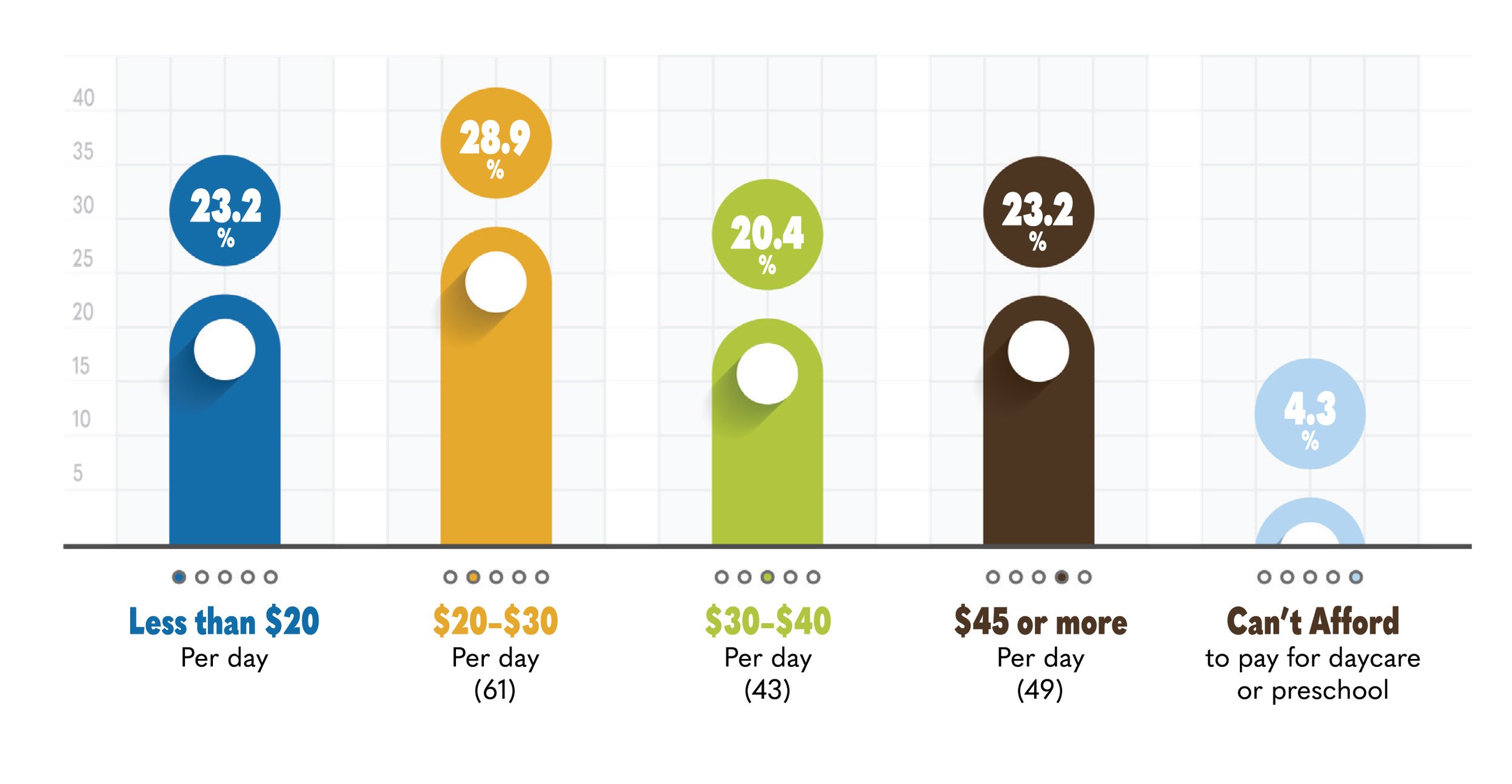
COMMUNITY NEEDS ASSESSMENT REPORT
Wood River Valley, Idaho
Early Care and Education Needs Assessment, January 2023
Overview
The Wood River Early Learning Collaborative (WRELC) was formed when the Wood River Women’s Foundation awarded the first-ever Focus Grant to “close the opportunity gap in education” to the Idaho Association for the Education of Young Children. Idaho AEYC works across the state of Idaho, using a collaborative model to bring together essential stakeholders who want to see high quality learning opportunities for families in their community. These collaboratives work to create robust system supports, expanding access and affordability of quality early learning programs and providing families with engagement opportunities through stronger community partnerships.
WRELC collected demographic data and conducted surveys of families and community members, businesses, and early learning providers from November of 2022 through January of 2023 to create this assessment. Key findings will inform a local strategic plan in the next phase of WRELC’s work to provide equitable access to high-quality and affordable early learning and care programs for all young children in our community.
EXECUTIVE SUMMARY
This community needs assessment was conducted to inform a forthcoming strategic plan for the Wood River Valley that will improve the quality, accessibility, and affordability of early education opportunities for families with young children. The data gathered highlights the pressing concerns surrounding early learning opportunities and care for the birth through five-year-old population, their families, and the early childhood providers in the Wood River Valley. The surveyed providers alone care for approximately 300 children, with over 90 on waiting lists. The affordability gap is a serious concern, with most families unable to pay more than $30 a day per child, and providers unable to sustain their businesses without charging at least $40 a day per child. The lack of “off-hours” care options for families and low wages for childcare providers also contribute to the crisis, affecting both working parents and employers, who often struggle to find and retain skilled staff.
However, the findings of this needs assessment also present encouraging and tangible opportunities for improvement and growth. The will and demand to expand is present with 85% of providers open to growing their programs with a larger facility, and 70% of stay-at-home parents surveyed stating they would return to work outside the home if quality and affordable childcare was available.
The Wood River Early Learning Collaborative recognizes the urgency in addressing this complex issue and is working expeditiously towards creating equitable access to quality and affordable care and early education opportunities. Over half of the children in the area are currently in informal care settings, highlighting the need to support choice, empower families and care givers, and ensure quality care and early learning for all children. Identifying and implementing solutions together is in our best interests, and the Wood River Early Learning Collaborative welcomes your support and involvement with strategic planning and beyond as this critical issue impacts our entire community.

COMMUNITY PROFILE BLAINE COUNTY
Although named the Wood River Early Learning Collaborative, ELAC members were clear that the Collaborative should include all municipalities within Blaine County.
Population: 24,766 (Census, 2021)
Children (2021):
• 0 – 17 years old: 4,919 • 5 – 9 years old: 3,904 • 0 – 4 years old: 1,015
Income (2022):
• Household median income: $86,735 • Per capita income: $40,739
Racial/Ethnic Groups by Town (2021):
• Bellevue: White – 64%; Hispanic – 31%; Two or More – 5%
• Carey: White – 48%; Hispanic – 52%; Two or More – less than 1%
• Hailey: White – 65%; Hispanic – 32%; Two or More – 4%
• Ketchum: White – 87%; Hispanic – 9%; Two or More – 2%
• Sun Valley: White – 83%; Hispanic – 10%; Two or More – 5%
Households with Language Other Than English Spoken at Home
Population Living in Poverty (2022):
• Total population living in poverty: 1,772 or 7%
• 0 – 17-year-olds living in poverty: 400 or 8%
• 5 – 17-year-olds living in poverty: 272 or 7%
• 0 – 4-year-olds living in poverty: 128 or 13%(2022): 23%
ALICE (Asset Limited, Income Constrained, Employed)
Households (2018):
• Total households in Blaine County: 8,190
• Households living in poverty: 11%
• ALICE households: 41%
• Households above ALICE level: 48%
BCSD Students in the Federal Free and Reduced Lunch Program (2022): 36%
BCSD Fall Kindergarten Data (2022):
• Kindergarten enrollment: 202 students
• Race: White – 39%; Hispanic – 49%; Unknown – 11%
• Limited English Proficient: 29%
• Kinder Readiness as measured by the Idaho Reading Indicator (IRI):
6% – tier 1; 16% – tier 2; 38% – tier 3*
Family Community Feedback
Family/Community surveys were created by the ELAC using Survey Monkey to create links and QR codes. The surveys were available in English and Spanish. A total of 469 surveys have been completed (431 English and 38 Spanish), which is 2% of the population of Blaine County.
Top three barriers to childcare are:
Not enough availability
Childcare is unaffordable for most families
Lack of off-hours care
Licensed childcare professionals are taking care of 46% of children age birth through 5 years old, followed by family members (29%), babysitters (12%), nannies (7%), and friends (6%).
Of those with children aged birth through 5 years old, 46% have a child or children in daycare or preschool and 9% would like to have their child in daycare or preschool but are on a waiting list or there is another barrier to access.
At 73%, there is a preference for daycare and preschool programs located in the south valley (Bellevue and Hailey). Although the survey has not been widely circulated in Carey, 5% stated a need for a daycare and preschool program in Carey (5%) which currently does not have any providers.
CHILDCARE PROVIDER FEEDBACK
An Early Childhood Provider survey was created by the Advisory Committee using Survey Monkey to create links and QR codes. 13 out of 17 providers in Blaine County completed the survey.
Of providers, 67% are located in the South Valley (Bellevue or Hailey) with 33% in the North.
All daycare Monday – Friday is offered by 92% of providers, however no providers offer any off-hours care on weekends and only 15% offer off-hours care on weekdays before 8:00 am and/or after 5:00 pm.
Of the providers surveyed, the programs together offer care for approximately
300 CHILDREN
with over
CHILDREN ON WAITING LISTS
85%
OF PROVIDERS WOULD OR MIGHT SERVE MORE CHILDREN IF THEY HAD LARGER FACILITY CAPACITY.
Monthly costs of programs range from $800 to $1,440 per month for one child. Only two providers offer care for $800 a month with the others charging more. Looking at daily cost, the two least expensive providers charge $40 per child. In addition, many programs have additional costs, including application fees, late pick up fees, and past due payment fees.
Tuition assistance in the form of a multi-child discount is offered by 54% of providers and 23% of providers have a continuing scholarship program. No providers have a sliding scale fee.
Only one provider takes payment through Idaho Childcare Program and other government programs such as Idaho Steps to Quality and the USDA Child and Adult Care Food Program.
Of the providers surveyed, the programs together offer care for approximately 300 children, with over 90 children on waiting lists.
Families with children aged birth to two years old have fewer options with only 38% of providers offering care for this population, with the number jumping slightly to 46% of providers caring for children aged 2 to 3 years old. All providers care for children aged 3 through 5 years old.
The average hourly pay for program staff is $19 an hour with 30 to 40 hours worked per week.
High staff turnover is an issue or somewhat of an issue for 46% of providers.
What families can afford to pay for a high-quality daycare or preschool for the child(ren):
The need for off-hours care (hours outside of an 8 am to 5 pm workday) are not being met, with 36% of families needing care before 8:00 am and/or after 5:00 pm on weekdays and 12% needing care options on weekends.
When those staying home to care for children aged birth through five were asked if they would return to the workforce if they could find quality and affordable care, 68% responded “yes” and 20% “maybe.” Only 12% responded “no”.
BUSINESS FEEDBACK
Business surveys were created by the ELAC using Survey Monkey to create links and QR codes. The surveys were available in English and Spanish. The ELAC will pursue conversations with business owners on more detailed needs and commitment to finding solutions in the strategic planning phase.
71% of businesses have 11 or more employees that regularly use childcare services.
Only 18% of businesses provide some type of financial assistance for families needing childcare services, and another 18% currently do not but would consider doing so.
88% of businesses agree or strongly agree that support of early childhood education and childcare services creates a stronger workforce, while 12% strongly disagree.
Business responses when asked how the performance of employees is impacted by childcare issues:
“Staff often have to arrive late or leave early to accommodate the limiting factors of childcare:
hours – closures – transportation – illness.”
“Negatively impacted by absenteeism and lack of work focus when there are concerns about availability, hours, and quality of childcare.”
“The lack of childcare options or affordable childcare options prevent us from hiring, retaining, and getting the most out of our employees.”
How often do your employees miss days of work due to childcare issues?
82%
OF BUSINESSES AGREE OR STRONGLY AGREE THAT SUPPORT OF EARLY CHILDHOOD EDUCATION AND CHILDCARE SERVICES IS VITAL TO THE STRENGTH OF OUR ECONOMY.
The Initial Early Learning Advisory Committee:
A core Early Learning Advisory Committee (ELAC) was formed in September and October of 2022 with the first meeting on October 24, 2022. The ELAC members who conducted the Needs Assessment in 2022-23 were:
Elise DeKlotz // Hailey Public Library, Children’s Librarian
Jim Foudy // Blaine County School District, Superintendent
Kristin Gearhart // Bellevue Public Library, Director
Harry Griffith // SV Economic Development, Executive Director
Kathryn Ivers // WR Early Learning Collaborative, Project Director
Jane Lopez // The Hunger Coalition, Community Organizing Supervisor
Laura Rose-Lewis // I Have a Dream Foundation Idaho, Executive Director
Janet Salvoni // Community School, Elementary School Head and Idaho AEYC Board Member
Sarah Seppa // St. Luke’s, Director of Community Engagement/Manager – Center for Community Health
Jason Shearer // YMCA, CEO
Tricia Swartling // The Advocates, CEO
The ELAC met every three weeks to create local surveys, get surveys completed, and to analyze the data for this assessment. Leaders of Idaho AEYC’s Early Learning Collaboratives Project joined in the meetings in an advisory capacity.
ADVISORY COMMITTEE COMMENTS
DATA SOURCES
The ELAC prepared surveys in both English and Spanish for local data collection that were circulated to families and community members, businesses, and early childhood providers by ELAC members and other community stakeholders.
• Family/Community Survey • Early Childhood Provider Survey • Business Survey
A larger group of community stakeholders participated in collecting data through surveys created by the ELAC and sharing existing relevant data set forth in this Needs Assessment.
Additional demographic statistics and relevant data were gathered from the following sources:
• Blaine County Education Foundation (2022)
• Blaine County School District (2022)
• Idaho Demographics (2021)
• Idaho Reading Indicator (IRI) / Assessment & Accountability / SDE (2022)
• Idaho – United for ALICE – Blaine County Profile (2018)
• RISE Registry via Region 5 IdahoSTARS (10/2022)
• St. Lukes Wood River Community Health Needs Assessment (2022)
• St. Luke’s Wood River Employee Housing Needs Study (2020)
• Sun Valley Economic Development Childcare Provider Data (2022)
• The Advocates – Data on Barriers to Childcare Access (5/2021)
• U.S. Census Bureau Quick Facts – Blaine County (2021)
• U.S. Census Bureau Small Area Income and Poverty Estimates for States, Counties and School Districts (2022)
This report was made possible due to the Focus Grant awarded to Idaho AEYC by the Wood River Women’s Foundation.
Idaho AEYC Team and Partners
Beth Oppenheimer Idaho AEYC, Executive Director
Martin Balben Idaho AEYC, Learning Collaborative Project Director
Heather Lee Idaho AEYC, Learning Collaborative Assistant Director
Lauren Sogor Advocacy Communication Solutions, Senior Strategist
If you would like to volunteer for any projects, please reach out to info@wrelc.org
Join our email list!
receive valuable communications about the state of this childcare crisis and the progress we are making!















